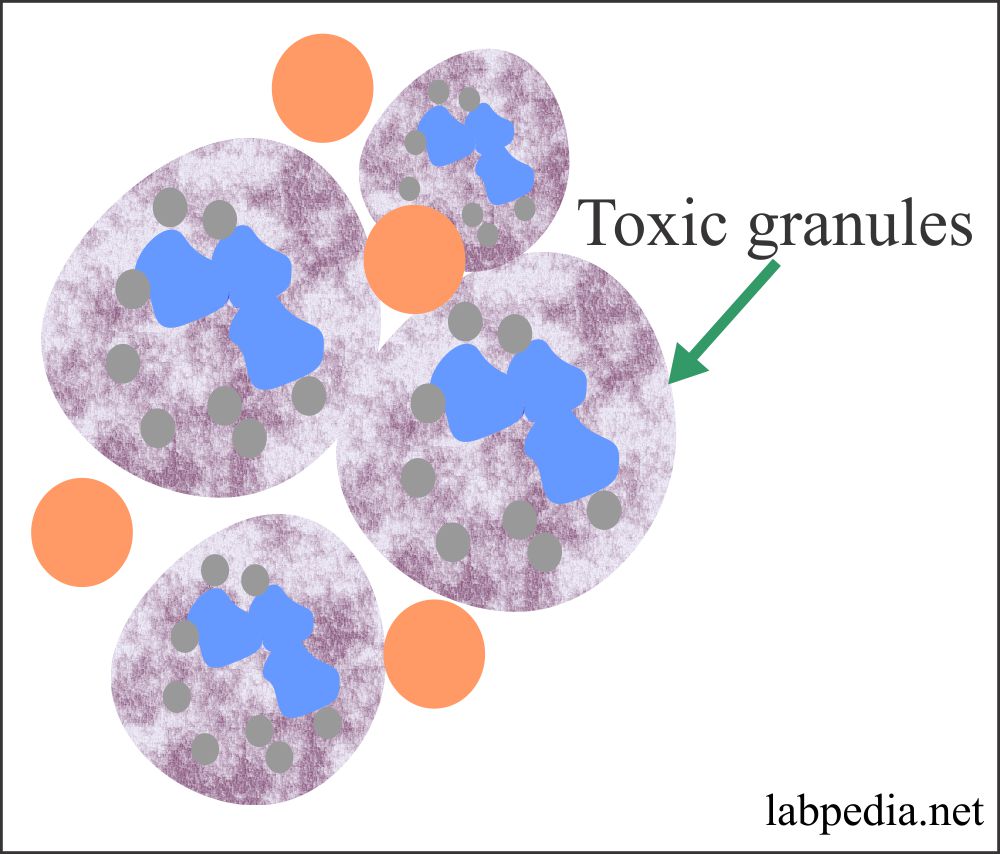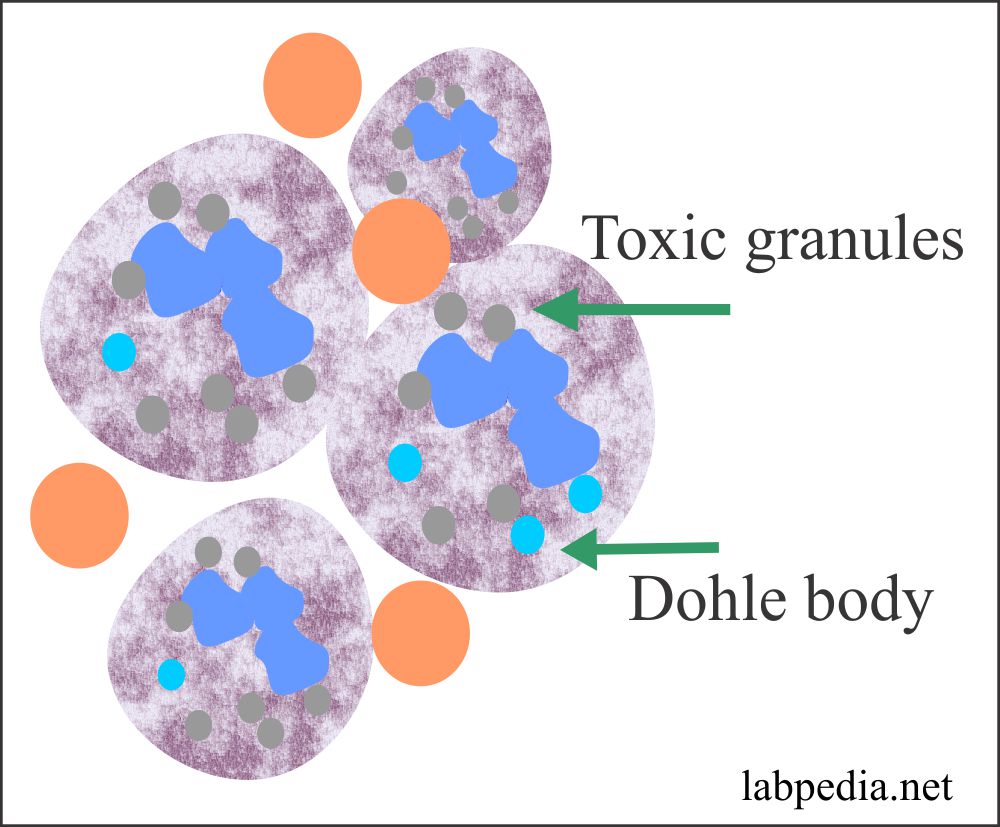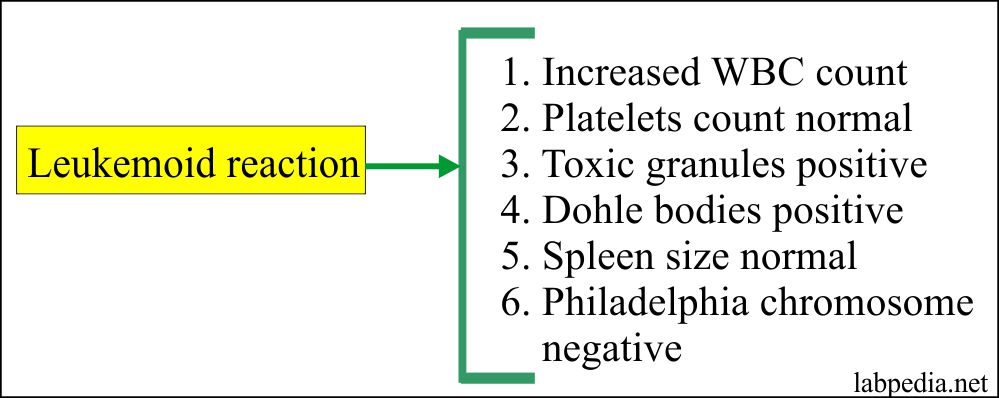Laboratory diagnosis of Leukemoid Reaction
Sample
- Blood in EDTA is needed along with fresh blood smear.
Definition
It may be lymphoid or myeloid.
If there is a persistent increase in the neutrophils, reactive and excessive leucocytosis with a count of 30,000 to 50,000 / µL, with the presence of immature and mature white cells in the peripheral blood smear is called Leukemoid reaction. Sometimes lymphocytic reaction maybe seen.
This is not primary marrow disorder, and this is due to the secondary to infections.
Significance
- This term is used to differentiate between the leucocytosis and leukemia.
- In leukocytosis or neutrophilia there is an increase in the count from 10,000 to 25,000 / µL (microliter).
Pathogenesis of leukemoid reaction:
- Leucocytosis results from the release of the cells from the bone marrow under the influence of IL-1 and TNF.
- There is a shift to the left of the neutrophils.
- Prolonged infection induces in the bone marrow, the proliferation of the precursor cells and that is also by the IL-1 and TNF.
- Bacterial infections induce a selective increase in the neutrophils while parasitic infestation induces eosinophilia.
- Mumps, Rubella, and some of the viruses leads to a selective increase in the lymphocytes and cause lymphocytosis.
The Differentiating Point From Leukemia:
- In the leukemoid reaction, the neutrophils are mature and not clonally derived.
- There is a persistent increase in TLC above 50,000/cmm and no evidence of leukemia.
- Blood count comes to normal after treating the cause.
- Increased blast cells are not seen in the leukemoid reaction.
- A count above 100,000 /µL is more suggestive of the myeloproliferative disorder with very few exceptions.
- Granulocytes show toxic granulations and Dohle bodies.
- NAP score is high which is low in leukemia.
- Leukemoid reaction shows:
- Toxic granulations.
- Toxic vacuolization.
- Presence of Dohle bodies. These are light blue to grey, oval, and maybe basophilic inclusions in the neutrophils. Usually seen in the peripheral area of the cytoplasm of neutrophils. These consist of ribosomes and endoplasmic reticulum.
Differential diagnosis includes:
- Chronic myeloid leukemia.
Causes Of Leukemoid Reaction:
- A severe infection like Clostridium, Tuberculosis, Pertussis, and Infectious mononucleosis.
- Visceral larva migration leads to eosinophilia.
- Tuberculosis gives rise to monocytosis.
- Fungal infection also causes neutrophilia with monocytosis.
- Leukemoid lymphocytosis is seen in Tuberculosis, Whooping cough, and infectious mononucleosis.
- Intoxication.
- malignancies.
- Severe hemorrhage.
- Acute hemolysis.
- Drugs like Sulfa, Dapsone, Glucocorticoids, and use of the G-CSF factor.
- Diabetic ketoacidosis.
- Ischemic colitis.
- Hepatic necrosis.
Difference between Leukemoid reaction and chronic myelocytic leukemia:
| Clinical parameters | Leukemoid reaction | Chronic myeloid leukemia |
| What is the basis | physiological process | pathological process |
| WBC count | usually <50,000/cmm | usually >50,000/cmm |
| Basophils | absent | usually increased count |
| platelets | normal | Increased |
| Eosinophil | normal | Increased |
| Hemoglobin | usually normal | usually low |
| Band form | these are prominent | all stages (myelocytes) |
| Toxic granules and Dohle bodies | these are present | toxic granules ± to 0 |
| Spleen | usually not present | usually enlarged |
| Philadelphia chromosome | absent | present in 90% of the cases |
| Leucocytes Alk.phosphatase (LAP) score | normal or increased > 100 | < 10 |
| History | short | long |
| After the treatment | Count becomes normal | This may be still raised |
Diagnosis
Conventionally, a leukocytosis exceeding 50,000 WBC/mm3 with a significant increase in early neutrophil precursors is referred to as a leukemoid reaction. The peripheral blood smear may show myelocytes, metamyelocytes, promyelocytes, and rarely myeloblasts; however, there is a mixture of early mature neutrophil precursors, in contrast to the immature forms typically seen in acute leukemia. Serum leukocyte alkaline phosphatase is normal or elevated in leukemoid reaction, but is depressed in chronic myelogenous leukemia. The bone marrow in a leukemoid reaction, if examined, may be hypercellular but is otherwise typically unremarkable.
Leukemoid reactions are generally benign and are not dangerous in and of themselves, although they are often a response to a significant disease state. However, leukemoid reactions can resemble more serious conditions such as chronic myelogenous leukemia (CML), which can present with identical findings on the peripheral blood smear. Historically, various clues including the leukocyte alkaline phosphatase score and the presence of basophilia were used to distinguish CML from a leukemoid reaction. However, at present the test of choice in adults to distinguish CML is an assay for the presence of the Philadelphia chromosome, either via cytogenetics and FISH, or via PCR for the BCR/ABL fusion gene. The LAP (Leukocyte Alkaline Phosphatase) score is high in reactive states but is low in CML. In cases where the diagnosis is uncertain, a qualified hematologist or oncologist should be consulted.
https://labpedia.net/leukemoid-reaction-and-diagnosis-d-d-from-chronic-myelocytic-leukemia/
https://en.wikipedia.org/wiki/Leukemoid_reaction
https://healthjade.net/leukemoid-reaction/
.




Comments
Post a Comment